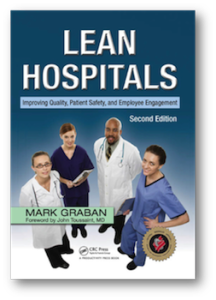2nd Edition (2011)
Learn more about the upcoming 3rd edition (June 2016)

Read a blog post, from the book’s author, about the second edition
Highlights of What Was New in the 2nd Edition:
- New and updated material on identifying waste, A3 problem solving, employee suggestion management, and strategy deployment
- New case studies—including a new Kanban case study (Northampton General Hospital) and another that ties together the themes of standardized work, Kanban, 5S, visual management, and Lean leadership for the prevention of patient harm
- New examples and updated data throughout, including revised chapters on patient safety and preventing medical errors
Details:
General
- “Points to Ponder” at the end of each chapter are now called “Points for Group Discussion,” with some new questions added.
Chapter 1
- Updated initial introduction (talking about “starting from need” in terms of why we use Lean methods and principles)
- Added callout talking about Toyota’s reputation and quality
- Updated lean history to reference Joan Wellman and Seattle Children’s early lean work
- Updated/new metrics that show lean improvement examples in healthcare
- Updated data on cost pressures, staff shortages, quality problems in healthcare
- New departmental case study (Children’s Medical Center Dallas – lab)
- 1st edition case example moved to later chapter on improving flow
- The bulk of the Avera McKennan case study (from 1st edition) moved to later chapter on getting started with lean
Chapter 2
- Various updates, including some references to ThedaCare’s lean management system
- Updated “Toyota Way” framework to change first pillar wording from “elimination of waste” to “continuous improvement” – the main idea is the same, but this is more consistent with Toyota wording
- New callout on “respect for people” pillar
- Added the “four rules in use” as a Lean definition framework
Chapter 3
- New introduction, “Waste is Not the Same as Cost”
- New data from Virginia Mason about reducing waste to free up RN time at the bedside
- Refined description of “pull” in healthcare, why pull should be about patients pulling on resources, not a unit “pulling” the patient when a room is available
- Improvements in the section on defining value, incorporating insights from Dr. Don Berwick
- Edits and, in some cases new examples, about the types of waste in healthcare
- Fuller discussion of “Required Waste”
Chapter 4
- Edits and some new examples in intro to value streams
- New callout on electronic VSM – downplaying the need for that software and technology
- New “activity of the employee” example for primary care physician, with new figure
Chapter 5
- New figure showing the “Park Nicollet System of Care” version of the “Lean House” diagram
- Edits and refined section on standardized work for healthcare
- New callout on looking at the communication process and standardized work instead of just blaming parents for not following NPO instructions properly.
- New callout on standardized work in a radiology department
- New section on determining staffing levels based on data
- New section on quick changeover as a form of standardized work (O.R. turnover, etc.)
- New material on managers coaching on standardized work, rather than being punitive when they see problems
- New material on lean, standardized work, and checklists
- New material on standardized work for managers
- New callout on standardized work and Training Within Industry (success story example)
Chapter 6
- New examples of visual management used to help manage patient flow
- New 5S callouts and small case examples
- New Kanban examples and new case study from Northampton General Hospital (UK), Seattle Children’s, Park Nicollet, Henry Ford Health System, New York HHC
- New material on Kanban vs. par levels
- New material on Kanban vs. automated inventory cabinets
- New culminating case study about the use of standardized work, 5S, Kanban, and visual management to prevent patient harm
Chapter 7
- New intro case study of the Mary McClinton case and lessons learned (Virginia Mason)
- New quality improvement data and examples from ThedaCare and others
- New examples and discussion about workarounds
- New section on A3 problem solving, with example
- New 5 Whys problem solving examples
Chapter 8
- New introduction and case example of patient harm and lessons learned (Darrie Eason case) – blame vs systems
- New examples about quality at the source and not blaming individuals
- New error proofing and quality improvement data and case examples
- New material about Lean and “Crew Resource Management”
- New material on Virginia Mason “patient safety alert” system
- New figures and photos
Chapter 9
- New intro – “Waiting: A Worldwide Problem” with data from many countries and waiting times and improvements
- New material on the “Seven Flows of Healthcare”
- New examples and data on flow improvements
- New material on matching staffing to demand in emergency departments
- New examples of E.D. flow improvement
- New case example (ThedaCare) on reducing door to balloon time
Chapter 10
- New quotes and callouts on lean leadership, including John Toussaint’s comparison of “white coat leadership” and “lean leadership.”
- New section on strategy deployment
- New material on goals versus hard targets and a warning about dysfunctions
- Additional material on daily standup meetings
- Updates on managing kaizen and continuous improvement
- Updated format for an “idea card” to be used on visual idea boards
Chapter 11
- New callouts about organizations getting started with Lean
- New material on “what do we call it?” – giving a name to a formal Lean program
- Updates on kaizen events – different formats and success/failure data updated
- Replaced LeBonheur Children’s Hospital “getting started” lean transformation case with updated/expanded version of Avera McKennan case
Chapter 12
- Updated and expanded “Vision for a lean hospital.”
